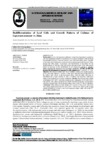Use este identificador para citar ou linkar para este item:
http://www.alice.cnptia.embrapa.br/alice/handle/doc/1053310| Título: | Dedifferentiation of Leaf Cells and Growth Pattern of Calluses of Capsicum annuumcv. Etna. |
| Autoria: | SANTOS, M. R. A. dos  SOUZA, C. A. de   |
| Afiliação: | MAURICIO REGINALDO ALVES DOS SANTOS, CPAF-Rondonia; Carolina Augusto de Souza. |
| Ano de publicação: | 2016 |
| Referência: | Australian Journal of Basic and Applied Sciences, v. 10, n. 12, p. 362-368, 2016. |
| Conteúdo: | Background:In vitrocell suspension cultivation systems have been largely reported assafe and standardized methods for production of secondary metabolites with medicinaland agricultural interest.Capsicum annuumis one of the most widely grown vegetablein the world and its biological activities have been demonstrated against insects, fungi,bacteria and other groups of organisms. The determination of procedures for thededifferentiation of cells into callus cells and the subsequent study of the callus growthpattern are necessary for the establishment of cellsuspensions and also to subsidizestudies regarding the bioactivity of its secondarymetabolites. To date, no study hasdescribed the development of protocols for callus induction inC. annuumL. cv. Etna. Objective:The objective of this study was to establish a protocol for dedifferentiationof leaf cells of the cultivarC. annuumcv. Etna and to determine the growth pattern ofthe calluses with a focus on the deceleration phase, when the callus cells must besubcultured into a liquid medium in order to establish cell suspension cultivationsaiming at the production of secondary metabolites.Results:The treatment that resultedin the highest %CI, ACCC and callus weight was thecombination of 4.52 μ M 2,4-D +0.44 μ M BA. The calluses produced were friable andwhitish and their growth patternfollowed a sigmoid shape. The deceleration phase started on the 23rdday of cultivation.Conclusion:Callus induction in leaf explants ofC. annuumcv. Etnacan be achieved inMS medium supplemented with 4.52 μ M 2,4-D + 0.44 μ MBA, which results in highcellular proliferation; in order to start a cell suspension culture, callus cells on the 23rdday of culture should be used. |
| Thesagro: | Curva de Crescimento Pimenta |
| NAL Thesaurus: | secondary metabolites |
| Palavras-chave: | Callogenesis Growth curve Metabolismo secundário Calogêneses |
| Tipo do material: | Artigo de periódico |
| Acesso: | openAccess |
| Aparece nas coleções: | Artigo em periódico indexado (CPAF-RO)  |
Arquivos associados a este item:
| Arquivo | Descrição | Tamanho | Formato | |
|---|---|---|---|---|
| DifferentiationSANTOS2016.pdf | 152.17 kB | Adobe PDF |  Visualizar/Abrir |









